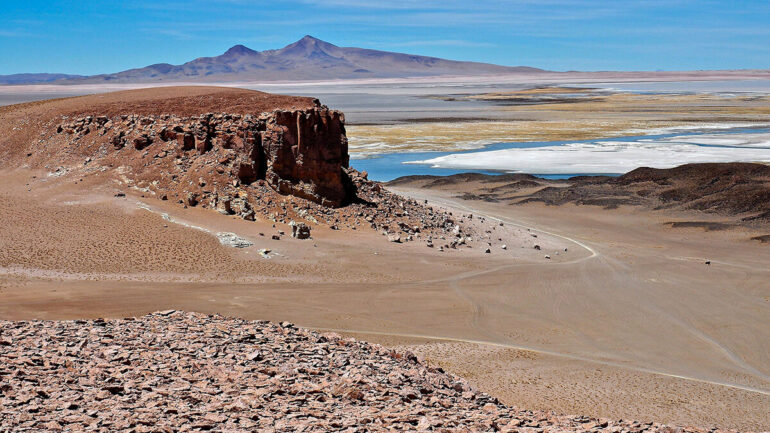In the enduring dryness of the Atacama Desert in northern Chile where the average rainfall is as low as 5 millimeters per year, rare rain events can come swiftly and intensely. They shape the landscape and provide precious moisture to plants and other species that otherwise adapted to extended dry spells or harvesting coastal fog. Intense rain events like those seen in the Atacama are known to be associated with so-called moisture conveyor belts, which are high-altitude atmospheric phenomena known for transporting large volumes of water vapor. However, whether or not moisture conveyor belts are responsible for the Atacama’s intense rain events has yet to be shown.
In a new study, Böhm et al. explain the atmospheric mechanisms behind the wettest of these precipitation events and propose that the water travels from the tropical Amazon across oceans and mountains to reach the desert. The research shows that 40%–80% of the total precipitation that occurs between the coast and the Andean foothills is associated with moisture conveyor belts.
Rain events related to moisture conveyor belts can be devastating for local microbial species adapted to dry conditions, the authors say, but they could play a role in the germination of the blooming desert—an explosion of colorful wildflowers that occurs in the Atacama every five to seven years. The authors’ understanding of the processes behind these rare events could change how scientists understand past and future climates in the region.
Cataloging conveyor belts
Böhm and colleagues cataloged the role of the conveyor belts in the Atacama for the first time. To figure out the role of moisture conveyor belts and track air masses, the researchers examined a 2017 precipitation event that brought more than 50 millimeters of rain to some regions of the Atacama. Modeling that tracked the paths of the air masses suggested that most of the moisture originated in the Amazon basin, a surprising result given the high Andes that divide the rain forest from the desert. The authors also discovered that moisture conveyor belts occur throughout the nearby Andes region about four times per year—some don’t bring much precipitation at all, but the wettest of them can be extreme.
“It’s like a decade worth of rain within one single event within a couple hours,” said Christoph Böhm, lead author of the study from the Institute for Geophysics and Meteorology at the University of Cologne in Germany. Ten times the annual precipitation can be rained down by these conveyor belts in the midsection of Earth’s lowest atmospheric layer, the troposphere.
In tracing how water moves in moisture conveyor belts across the continent, the researchers suggest that in the most humid of these extreme events, the moisture originates in the tropical Amazon basin rather than over the Pacific Ocean that lies west of the desert.
However, additional research is needed to confidently show that the Amazon is the source of the moisture brought by some of the conveyor belts. An examination of isotopic data—the atomic chemical information of the water—from the rain events is necessary to support this idea, according to Cornell University geologist Teresa Eileen Jordan, who studies the Atacama and was not involved in the research. The hypothetical path of the water from the Amazon over the Andes would fundamentally change the chemical composition of the water, she says.
New ideas about how water is transported to these regions can shape how paleoclimatologists understand past eras in this region, affecting understandings of past civilizations that may also have depended on these processes, and can inform water resource management and predictions of future climate change in the Atacama Desert.
More information:
Christoph Böhm et al, The Role of Moisture Conveyor Belts for Precipitation in the Atacama Desert, Geophysical Research Letters (2021). DOI: 10.1029/2021GL094372
Provided by
American Geophysical Union
This story is republished courtesy of Eos, hosted by the American Geophysical Union. Read the original story here.
Citation:
Understanding rare rain events in the driest desert on Earth (2022, January 18)



